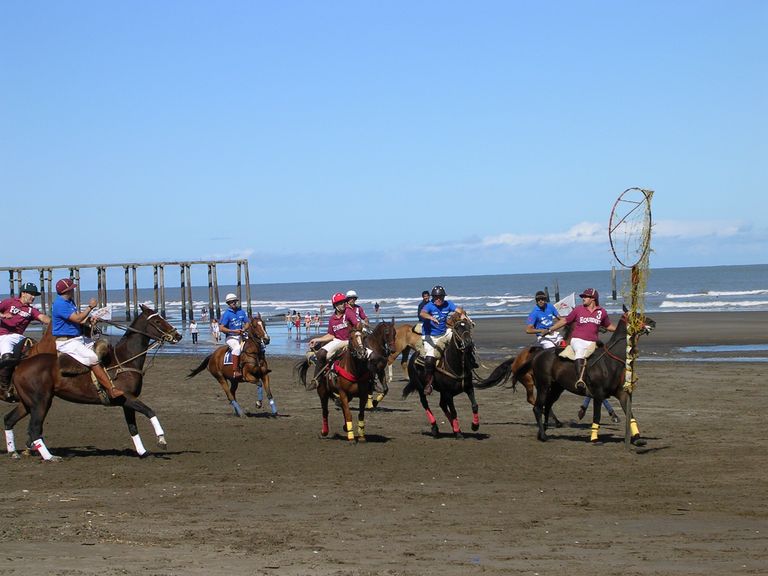
Deporte viril, para gente de a caballo, audaz y valiente, "El Pato" se practica en Argentina desde principios del siglo XVII, tal como lo muestra una crónica de Felix de Azara en la que relata una "corrida" realizada en Buenos Aires en el año1610 (30 años después de la Segunda Fundación de Buenos Aires, por Juan de Garay) con motivo de las fiestas de beatificación de San Ignacio de Loyola.
Dice el naturista: "se juntan para esto dos cuadrillas de hombres de a caballo y se señalan dos sitios apartados como de una legua (cinco kilómetros aproximadamente). Luego cosen un cuero en el que se ha introducido un pato vivo que deja la cabeza afuera, teniendo el referido cuero dos o mas asas o manijas, de las que se toman los dos mis fuertes de cada cuadrilla en la mitad de la distancia de los puntos asignados y metiendo espuelas tiran fuertemente hasta que el mas poderoso se lleva el pato, cayendo su rival al suelo si no lo abandona.
El vencedor echa a correr y los del bando contrario lo siguen y lo rodean hasta tomarlo de alguna de las manijas, tiran del mismo modo, quedando al fin vencedora la cuadrilla que llego con el pato al punto señalado".
El jesuita Diego de Torres Bello S.J. escribía una primera misiva a sus Superiores, el 16 de junio de 1610 contando que, en todas las ciudades del Río de la Plata, se había celebrado con actos religiosos, sociales y culturales la beatificación del fundador de la Compañía de Jesús, San Ignacio de Loyola. Y que en Buenos Aires, "hizo su oficio la artillería y mosquetería, y salieron algunos con intenciones de regocijo a correr patos delante de nuestra iglesia". "Dos grupos de jinetes corrieron patos delante de nuestra Iglesia (fue en medio de lo que hoy es la Plaza de Mayo). A todos causo admiración verlos así a ellos, como a los caballos que parecían incansables corriendo con tanta incomodidad
La segunda misiva enviada, del 4 de Abril de 1611, llama mucho la atención, como que los participantes fueron dos tribus indias y por cierto que los españoles, con toda lógica, no les facilitaban caballos ni les permitían montar dado que eran unas de sus principales armas de conquista y guerra. Sin embargo, consigna que " Padres procedentes de Córdoba estimularon con premios a indios del valle calchaquí para que tiraran flechas a la sortija y corrieran patos". Los locales, calchaquíes, vencieron a los visitantes, Huachipas. No se refiere en nada en lo que hace al juego y su desarrollo. Su lectura hace suponer que perseguían patos vivos que disparaban por las calles de Bs. As. y por los valles. (Hay copias de las cartas en el colegio Del Salvador).
Ni los españoles introdujeron este bravío deporte, ni lo hallaron practicado entre los indígenas. Lo primero es evidente, pues era un deporte desconocido entonces, y aun ahora, en España, y no pudo provenir de los naturales, pues éstos no conocieron el caballo, el que fue importado por los españoles en la primera mitad del siglo XVI. Parecería que se trata de un juego criollo, elaborado y planeado por los conquistadores mismos, o por sus inmediatos descendientes.
Don Pedro de Mendoza fue el introductor del caballo en el año 1536 por estas tierras, aunque su descendencia (las manadas) fueron producto de los pocos que abandonó (hablan de cinco yeguas y siete padrillos) en 1541, Don Irala al abandonar Buenos Aires. Estos se acrecentaron hasta el infinito junto con los que trajo el increíble Cabeza de Vaca (ahora por estos pagos del Sur) en su marcha desde la costa brasileña hasta el Paraguay. Y en ese mismo año de 1542, por Diego de Rojas y en 1550, por Nuñez del Prado, ambos en sus incursiones por el norte de nuestro país.
Juan de Garay, hacia 1581, estimaba en 80.000 animales los caballos que vagaban salvajes (cimarrones) en un perímetro de 30 leguas de Buenos Aires. Catorce años después, 1595, cuando el rey solicitó al gobernador del Río de la Plata, Valdés de la Banda, un informe sobre la caballada que habitaba "la pampa", este contesta así: "Digo que D. Pedro Mendoza que fue el primer poblador de esta ciudad y puerto, trajo aquí caballos y yeguas que se quedaron en la campaña de esta tierra que es muy ancha y larga y en mas de 80 leguas no se halla una tan sola piedra, teniendo en mas de 100 leguas a la redonda tanta cantidad de yeguas y caballos que parecen montes cuando se ven de lejos y son tantos en numero que exceden a aquel gran numero que dicen los historias que había en las dehesas de la provincia de Media que se servían los reyes de Persia..." Bueno, bueno, algo exagerado, sin duda. Pero esto es el origen de sus millones de descendientes y promotores de la gran revolución del modo de vivir de todos los habitantes autóctonos y de quienes les siguieron. Y donde había y hay caballos existen estos juegos, estas destrezas, los deportes hípicos.
Una descripción mas detalladas, es la de Amadeo Frezier (Francés, 1682 – 1773) , un militar ingeniero especializado en fortificaciones, que durante algo mas de 2 años navegó " los mares del Sur". Corría 1712 y escribe en su libro, editado en 1716: " Fui testigo de una fiesta que los encomenderos de dos españoles que se llamaban Pedro se dieron el día del santo de sus amos en una aldea de Talcahuano, cerca de la cual estábamos anclados. Después de oír misa montaron a caballo para correr la gallina, como se corre la oca en Francia, con unas diferencias: que todos se arrojaban sobre el que ha obtenido la cabeza para quitársela y llevársela ante aquel en honor del cual hacen la fiesta; corriendo a todo galope se topaban para quitársela y a la carrera recogía del suelo todo lo que derribaban por tierra. Después de esta carrera se apearon para la comida".
El novelista argentino William Henry Hudson (1841 – 1922) en su difundido libro "EL Ombú" expresa que "El Pato era el entretenimiento más popular practicado al aire libre en la Argentina".
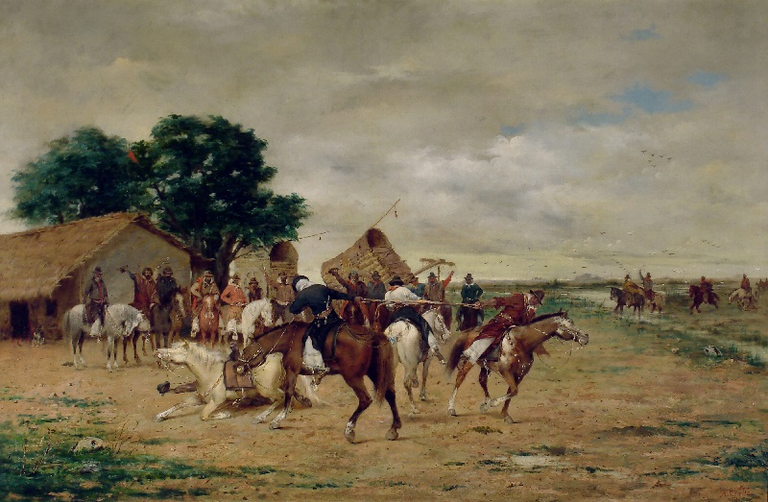

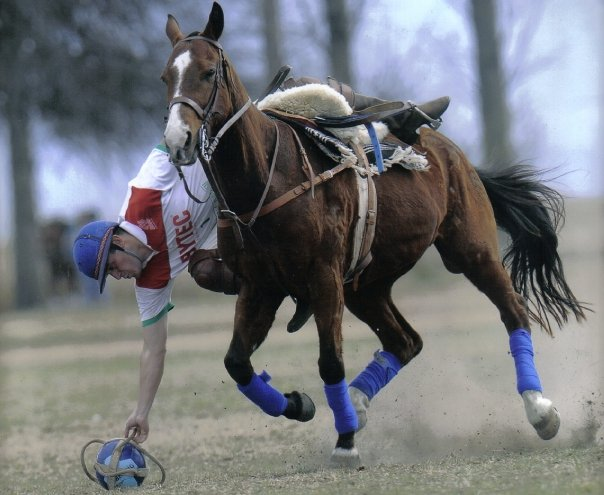
A virile sport, for people on horseback, bold and brave, “El Pato” has been practiced in Argentina since the early seventeenth century, as shown in a chronicle by Felix de Azara in which he recounts a “corrida” held in Buenos Aires in 1610 (30 years after the Second Foundation of Buenos Aires, by Juan de Garay) on the occasion of the feast of the beatification of St. Ignatius of Loyola.
The naturist says: “two teams of men on horseback get together for this purpose and mark two places about a league apart (five kilometers approximately). Then they sew a leather in which a live duck has been introduced leaving the head outside, having the referred leather two or more handles, of which the two strongest of each team take half the distance of the assigned points and putting spurs they pull strongly until the most powerful one takes the duck, his rival falling to the ground if he does not abandon it.
The winner starts to run and those of the opposing side follow him and surround him until they take him by one of the handles, pulling in the same way, and in the end the winning team is the one that arrived with the duck at the designated point”.
The Jesuit Diego de Torres Bello S.J. wrote a first missive to his Superiors, on June 16, 1610 telling that, in all the cities of the River Plate, the beatification of the founder of the Society of Jesus, Saint Ignatius of Loyola, had been celebrated with religious, social and cultural acts. And that in Buenos Aires, “the artillery and musketry did their job, and some went out with rejoicing intentions to run ducks in front of our church”. “Two groups of horsemen ran ducks in front of our church (it was in the middle of what today is Plaza de Mayo). Everyone was amazed to see them, as well as the horses that seemed tireless running with so much discomfort”.
The second missive sent, dated April 4, 1611, calls much attention, as the participants were two Indian tribes and certainly the Spaniards, with all logic, did not provide them with horses nor allowed them to ride since they were one of their main weapons of conquest and war. However, it states that “Fathers from Córdoba stimulated Indians from the Calchaquí valley with prizes so that they would shoot arrows at the ring and race ducks”. The locals, Calchaquíes, defeated the visitors, Huachipas. It does not refer at all to the game and its development. Its reading suggests that they chased live ducks that they shot through the streets of Buenos Aires and the valleys. (There are copies of the letters in the Del Salvador school).
Neither the Spaniards introduced this brave sport, nor did they find it practiced among the natives. The former is evident, since it was a sport unknown then, and even now, in Spain, and it could not have come from the natives, since they did not know the horse, which was imported by the Spaniards in the first half of the 16th century. It would seem that it is a Creole game, elaborated and planned by the conquistadors themselves, or by their immediate descendants.
Don Pedro de Mendoza was the introducer of the horse in the year 1536 in these lands, although his descendants (the herds) were the product of the few that Don Irala abandoned (they speak of five mares and seven stallions) in 1541 when he left Buenos Aires. These were increased to infinity together with those brought by the incredible Cabeza de Vaca (now in these southern regions) on his march from the Brazilian coast to Paraguay. And in the same year of 1542, by Diego de Rojas and in 1550, by Nuñez del Prado, both in their incursions to the north of our country.
Juan de Garay, around 1581, estimated in 80,000 animals that roamed wild (cimarrones) in a perimeter of 30 leagues from Buenos Aires. Fourteen years later, 1595, when the king asked the governor of the Río de la Plata, Valdés de la Banda, for a report on the horses that inhabited “la pampa”, he answered: “I say that D. Pedro Mendoza, who was the first settler of the pampas, was the first to settle in Buenos Aires. Pedro Mendoza who was the first settler of this city and port, brought here horses and mares that stayed in the campaign of this land that is very wide and long and in more than 80 leagues there is not a single stone, having in more than 100 leagues around so many mares and horses that seem mountains when seen from afar and are so many in number that exceed that great number that the stories say that there were in the pastures of the province of Media that served the kings of Persia...” Well, well, somewhat exaggerated, no doubt. But this is the origin of their millions of descendants and promoters of the great revolution in the way of life of all the native inhabitants and those who followed them. And where there were and are horses, there are these games, these skills, these equestrian sports.
A more detailed description is that of Amadeo Frezier (French, 1682 - 1773), a military engineer specialized in fortifications, who sailed the “South Seas” for more than two years. It was 1712 and he wrote in his book, published in 1716: “I witnessed a feast that the encomenderos of two Spaniards named Pedro gave themselves on the day of the saint of their masters in a village of Talcahuano, near which we were anchored. After hearing mass they mounted on horseback to run the hen, as they run the goose in France, with some differences: they all threw themselves on the one who had gotten the head to take it off and bring it to him in honor of whom they make the feast; running at full gallop they ran into each other to take it off and in the race they picked up from the ground everything they knocked to the ground. After this race they got off for lunch”.
The Argentinean novelist William Henry Hudson (1841 - 1922) in his well known book “EL Ombú” expresses that “El Pato was the most popular entertainment practiced outdoors in Argentina”.
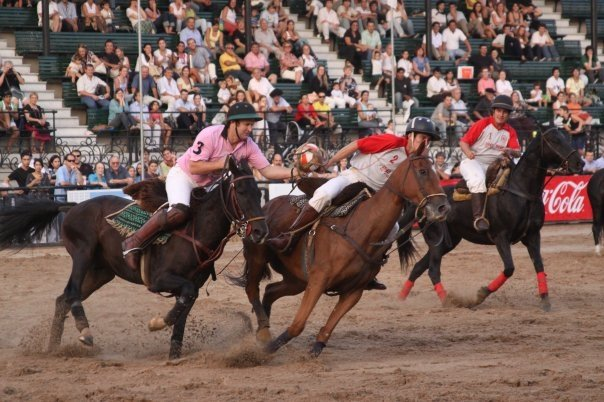
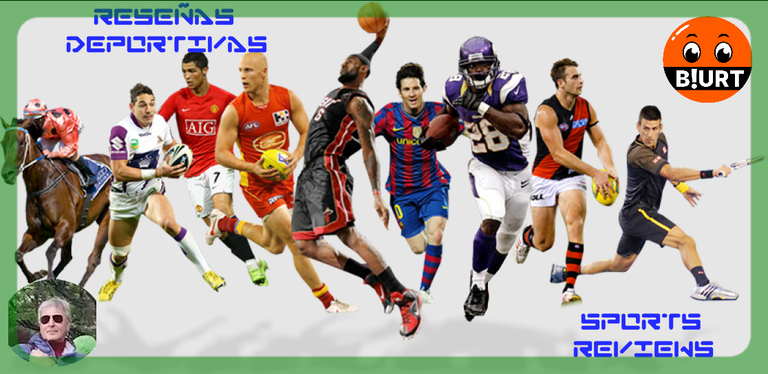


Sources consulted (my property) for the preparation of this article. Some paragraphs may be reproduced textually.
Fuentes consultadas (de mi propiedad) para la elaboración del presente artículo. Algunos párrafos pueden estar reproducidos textualmente.
| Argentina Discovery. |  | |
|---|---|---|
| Galería Fotográfica de Argentina. |  | |
| Viaggio in Argentina. |  |
Telegram and Whatsapp
Thanks @blurtconnect-ng.